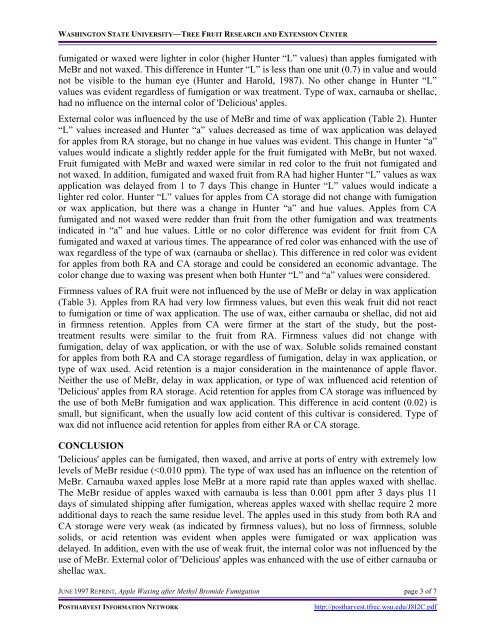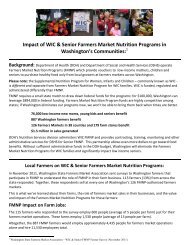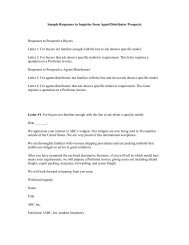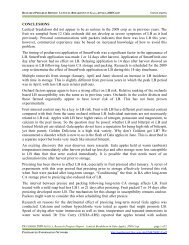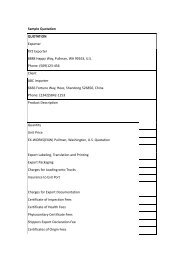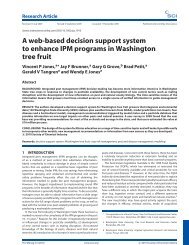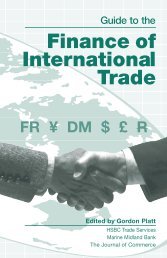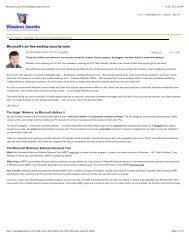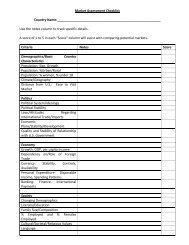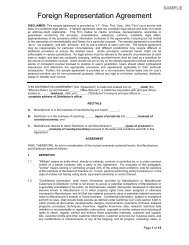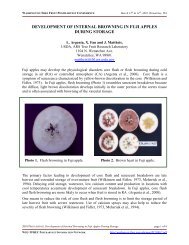WASHINGTON STATE UNIVERSITY—TREE FRUIT RESEARCH AND EXTENSION CENTERRecently, the Washington State apple industry has expressed interest in the waxing of apples<strong>after</strong> MeBr fumigation to improve their appearance for export. This study was conducted todetermine the time required <strong>after</strong> exposure to MeBr for the adsorption and desorption to occur sofruit could be waxed and arrive at foreign markets with no MeBr residue. MeBr residue <strong>after</strong>waxing with either shellac or carnauba wax and subsequent fruit quality was determined.MATERIALS AND METHODSUnwaxed 'Delicious' apples, size 113, were obtained from a local packinghouse in late Octoberfrom regular atmosphere (RA) and again in late January from controlled atmosphere (CA).<strong>Apple</strong>s from both types of storage averaged less than 14 lbs. of firmness prior to fumigation.<strong>Apple</strong>s were held at 1 °C until conditioning at 20 °C for 12 hrs. prior to MeBr treatment. Allfumigations of MeBr were at 56 g/m 3 for 2 hrs. at 10 °C of exposure and 2 hrs. of aeration.<strong>Fumigation</strong>s were conducted at normal atmosphere pressure in 28.3-liter fiberglass chambersequipped with circulating fans that operated continuously throughout the exposure period. At 0,1, 3, 5, and 7 days <strong>after</strong> fumigation, apples were waxed using either shellac (Shield Brite AP40)or carnauba (Shield Brite AP50) wax and dried at 60 °C. After waxing, the apples were boxedwith poly liners, returned to cold storage, removed <strong>after</strong> 30 or 60 days and evaluated.A sample of 16 apples of each combination of time <strong>after</strong> fumigation (5), type of wax (2) andreplication (3) was evaluated for quality. Eight apples were evaluated immediately <strong>after</strong> removalfrom storage; the remaining 8 apples were evaluated <strong>after</strong> 7 days at ambient temperature. <strong>Apple</strong>swere evaluated for firmness, objective and subjective color, soluble solids content (SSC),titratable acidity, and physiological disorders as previously re-ported (Drake et al., 1990).Four apples of each combination (time <strong>after</strong> fumigation, type of wax, and replication) wereevaluated for MeBr residue. Organic MeBr residue analyses were conducted using the method ofKing et al. (1981). <strong>Apple</strong>s used for organic MeBr residue were waxed as described, held in coldstorage (1 °C) for 11 days to simulate the time required for shipping to the Far East, and thenfrozen until analysis. Average values, analysis of variance, and test for significance using theKruskal-Wallis k-sample test were determined by SAS (SAS Institute, 1985).RESULTS AND DISCUSSIONOrganic MeBr residue present in apples <strong>after</strong> waxing is dependent upon the type of wax used andthe time <strong>after</strong> MeBr exposure (Table 1). The use of carnauba wax allows the MeBr residue todissipate faster than does the use of shellac wax. With carnauba wax, the MeBr residue levelsdeclined rapidly to the point where they were less than 0.001 ppm when apples were waxed 5days <strong>after</strong> fumigation and held for an 11-day simulated shipping period.With shellac wax, the residue levels were still 0.003 ppm when the fruit were waxed 7 days <strong>after</strong>fumigation and held for 11 days. MeBr residue levels were less than 0.010 ppm using eithercarnauba or shellac wax 3 days <strong>after</strong> fumigation and held for 11 days to simulate shipping.Internal discoloration has been reported when 'Delicious' apples have been fumigated with MeBr(Kenworthy and Gaddis, 1946; Drake et al., 1990). In this study, no internal discoloration of'Delicious' apples was evident (Table 2). The internal color of apples from RA storage wereidentical in objective Hunter “L”, “b” and hue values and subjective visual values (data notshown) regardless of the use of MeBr as a fumigant or the type or time of waxing. <strong>Apple</strong>s fromCA storage were identical in objective Hunter “a” and hue values and subjective visual values.Hunter “L” values were different depending on time of application of wax. <strong>Apple</strong>s from CA notJUNE 1997 REPRINT, <strong>Apple</strong> <strong>Waxing</strong> <strong>after</strong> <strong>Methyl</strong> <strong>Bromide</strong> <strong>Fumigation</strong> page 2 of 7POSTHARVEST INFORMATION NETWORKhttp://postharvest.tfrec.wsu.edu/J8I2C.pdf
WASHINGTON STATE UNIVERSITY—TREE FRUIT RESEARCH AND EXTENSION CENTERfumigated or waxed were lighter in color (higher Hunter “L” values) than apples fumigated withMeBr and not waxed. This difference in Hunter “L” is less than one unit (0.7) in value and wouldnot be visible to the human eye (Hunter and Harold, 1987). No other change in Hunter “L”values was evident regardless of fumigation or wax treatment. Type of wax, carnauba or shellac,had no influence on the internal color of 'Delicious' apples.External color was influenced by the use of MeBr and time of wax application (Table 2). Hunter“L” values increased and Hunter “a” values decreased as time of wax application was delayedfor apples from RA storage, but no change in hue values was evident. This change in Hunter “a”values would indicate a slightly redder apple for the fruit fumigated with MeBr, but not waxed.Fruit fumigated with MeBr and waxed were similar in red color to the fruit not fumigated andnot waxed. In addition, fumigated and waxed fruit from RA had higher Hunter “L” values as waxapplication was delayed from 1 to 7 days This change in Hunter “L” values would indicate alighter red color. Hunter “L” values for apples from CA storage did not change with fumigationor wax application, but there was a change in Hunter “a” and hue values. <strong>Apple</strong>s from CAfumigated and not waxed were redder than fruit from the other fumigation and wax treatmentsindicated in “a” and hue values. Little or no color difference was evident for fruit from CAfumigated and waxed at various times. The appearance of red color was enhanced with the use ofwax regardless of the type of wax (carnauba or shellac). This difference in red color was evidentfor apples from both RA and CA storage and could be considered an economic advantage. Thecolor change due to waxing was present when both Hunter “L” and “a” values were considered.Firmness values of RA fruit were not influenced by the use of MeBr or delay in wax application(Table 3). <strong>Apple</strong>s from RA had very low firmness values, but even this weak fruit did not reactto fumigation or time of wax application. The use of wax, either carnauba or shellac, did not aidin firmness retention. <strong>Apple</strong>s from CA were firmer at the start of the study, but the posttreatmentresults were similar to the fruit from RA. Firmness values did not change withfumigation, delay of wax application, or with the use of wax. Soluble solids remained constantfor apples from both RA and CA storage regardless of fumigation, delay in wax application, ortype of wax used. Acid retention is a major consideration in the maintenance of apple flavor.Neither the use of MeBr, delay in wax application, or type of wax influenced acid retention of'Delicious' apples from RA storage. Acid retention for apples from CA storage was influenced bythe use of both MeBr fumigation and wax application. This difference in acid content (0.02) issmall, but significant, when the usually low acid content of this cultivar is considered. Type ofwax did not influence acid retention for apples from either RA or CA storage.CONCLUSION'Delicious' apples can be fumigated, then waxed, and arrive at ports of entry with extremely lowlevels of MeBr residue (


